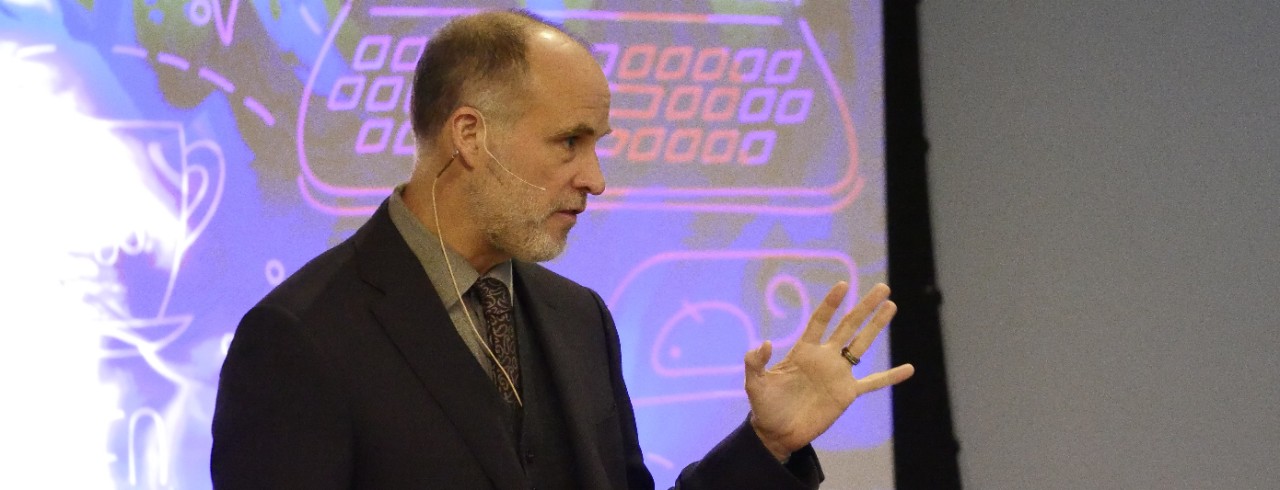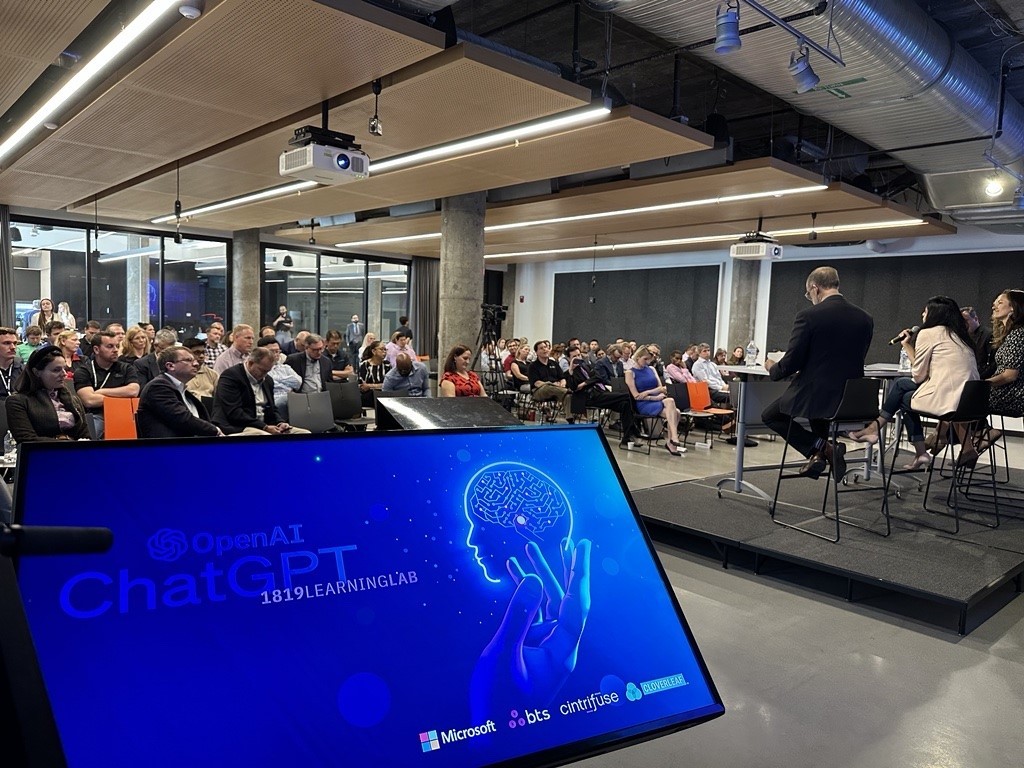
Tech experts discuss AI breakthroughs at UC 1819 Innovation Hub
Strategic partners unite, educating leaders from across the region
At the University of Cincinnati's 1819 Innovation Hub, strategic partners Microsoft, BTS and Cintrifuse joined forces in early June to showcase advancements in artificial intelligence (AI).
The event was an 1819 Learning Lab Discover Session designed to help Cincinnati Innovation District partner companies understand emerging technologies and how they can create new opportunities and advantages for their business.
In what was described by attendees as “information-packed,” “compelling” and “engaging,” the event brought together innovation leaders from the greater Cincinnati region to discuss the pros and cons of AI. Presenters and panelists included:
- Peter Mulford, global partner and chief innovation officer with BTS
- Melissa Lacefield, principal Azure cloud solution architect, Microsoft
- Madiha Khan, category lead, banking and capital markets, Azure Marketplace, Cloud and AI, Microsoft
- Pete Blackshaw, CEO of Centrifuse
- Kirsten Moorefield, co-founder and COO of Cloverleaf
AI is the simulation of any cognitive task using math by training algorithms to use predictive insights from data.
Peter Mulford Global partner and chief innovation officer, BTS
Demos and explainers

Panelists answer questions from attendees about the future of AI. Photo/Olivia Bransford
Mulford gave a presentation on AI’s capabilities. He broke it down for attendees stating, "AI is the simulation of any cognitive task using math by training algorithms to use predictive insights from data."
During his presentation, Mulford addressed how deeply integrated digital technology is in our lives and how people have been adjusting their social behaviors as a result. He left the audience three points to ponder:
- If we rely on AI in the future the way we rely on our smartphones today, what outcomes could we expect?
- What new skills or mindsets will we need for AI?
- What assumptions or beliefs do we need to let go of?
Lacefield gave a live demonstration of Azure Open AI, Microsoft’s cloud-based platform for developers and data scientists. Guests witnessed in real time how Azure OpenAI is equipped with responsible AI built-ins and how it works with generative text models such as ChatGPT and specialized generative coding models like Codex.
Panel presentation
Much of the panel discussion focused on ChatGPT, which stands for “generative pre-trained transformer.” The software is an AI-driven natural language processing tool developed by OpenAI.
Mulford, who moderated the discussion, explained that since the inception of the World Wide Web, advanced technology has been tracking data. Mulford also shared his thoughts on AI tools including ChatGPT.
“I think there's tremendous opportunity to unlock value so we can all become better business leaders,” he said. “We just need to think creatively about how these incredible tools can open new opportunities, and at the same time, we’ve got really difficult issues, tensions and ethical questions to consider.”
Expanding on his statement, Mulford invited panelists to share their thoughts on what excited them about AI and what concerned them as they segued into the Q&A.
Questions and answers
During the Q&A session, some attendees were enthusiastic about the technologies presented and curious to learn more about the ethical considerations and responsible development of AI to safeguard their businesses from misuse or misinformation.
Moorefield addressed concerns related to how students can use AI to do their homework for them or use AI systems that prompt them to think and help them learn.
“We worry that AI could take over, and that starts on the individual level in how we use it. Will we let it do the thinking for us or will we hold ourselves accountable to use it to make us better critical thinkers?” she said. “And a big part of that is in how we hold AI companies accountable to the data inputs they're using and how transparent they are about those inputs. AI can be used to make humanity stronger, and we get to choose — based on how we use it — if it makes us stronger or weaker."
The presenters cautioned that AI is not intended to replace jobs. Instead, it aims to enhance the impact of employees using human skills like empathy, creativity and engagement. When combined with AI, the panelists noted, these vital human skills can empower employees, entrepreneurs and the nation for the greater good.
Featured image at top: Peter Mulford, global partner and chief innovation officer with BTS. Photo/Olivia Bransford
Innovation Lives Here
The University of Cincinnati is leading public urban universities into a new era of innovation and impact. Our faculty, staff and students are saving lives, changing outcomes and bending the future in our city's direction. Next Lives Here.
Related Stories
UC’s microchip training includes innovative VR
July 2, 2024
To build a virtual microchip factory, University of Cincinnati doctoral students turned to the real one where they work. UC launched a new training program for microchip manufacturing in advance of the new fabrication plant Intel Corp. is opening in Ohio.
The entrepreneur’s guide to the power of networking
As an entrepreneur, connections with other business leaders can be just as valuable as the ideas and products that are brought to market. You can open doors to exciting opportunities, gain valuable insights and establish a robust support system through meaningful connections. Here’s why networking is essential and how you can leverage it to your advantage.
Bridging creativity and commerce
July 1, 2024
At the University of Cincinnati’s Carl H. Lindner College of Business, Victoria Mrofchak stands out not just for her academic excellence but for her remarkable blend of creativity and business acumen. A fourth-year marketing major with a minor in management and fine arts, scholarships help Mrofchak shape her future at the intersection of art and commerce.
Get to know Lisa Huffman, new dean of UC's CECH
July 1, 2024
UC News spoke with incoming CECH dean, Lisa Huffman, about her past experiences, the role family plays in her life, academic philosophies, goals for her time in this position and more. As we welcome the newest dean to University of Cincinnati, we encourage you to read on to learn more about Dean Huffman.
Meet UC’s Miss Ohio
July 1, 2024
UC biomedical science student Stephanie Finoti credits UC for helping to prepare her for the Miss Ohio Scholarship Pageant. She will represent Ohio in the national competition in January.
UC alum visits campus to teach students about footwear design
June 28, 2024
A 2011 graduate of design, UC alum Charley Hudak has seen his career trajectory go from intern to creative director for Tiger Woods' new athletic footwear brand, Sun Day Red. While he may run with the biggest cat in golf, Hudak doesn't forget his Bearcat roots and comes back each summer to teach youth about footwear design at DAAP Camps.
Cincinnati researchers want to know if MRIs can work better
June 28, 2024
WVXU and the Cincinnati Business Courier highlighted a new collaboration between the University of Cincinnati College of Medicine, UC Health GE HealthCare, JobsOhio, REDI Cincinnati and Cincinnati Children’s to create an MRI Research and Development Center of Excellence located on UC’s medical campus.
UC 1819 Innovation Hub workshop spreads AI awareness
June 28, 2024
Microsoft and Disrupt Now joined forces to run a June 24-27 seminar at UC’s 1819 Innovation Hub teaching Cincinnati residents how to responsibly use AI.
Free Wi-Fi, work area coming to Greater Cincinnati
June 27, 2024
St. Lawrence Park in Price Hill now has free Wi-Fi and a furnished outdoor space for community members to access digital needs. The space is part of The Nodes Project, which stands for “Neighborhoods of Design Engagement": a collaboration between UC DAAP communication designers and community entities.
University of Cincinnati, UC Health collaborate with GE HealthCare on MRI research center
June 26, 2024
The University of Cincinnati and UC Health are collaborating with GE HealthCare, JobsOhio, REDI Cincinnati and Cincinnati Children’s to create an MRI Research and Development Center of Excellence located on UC’s medical campus.
